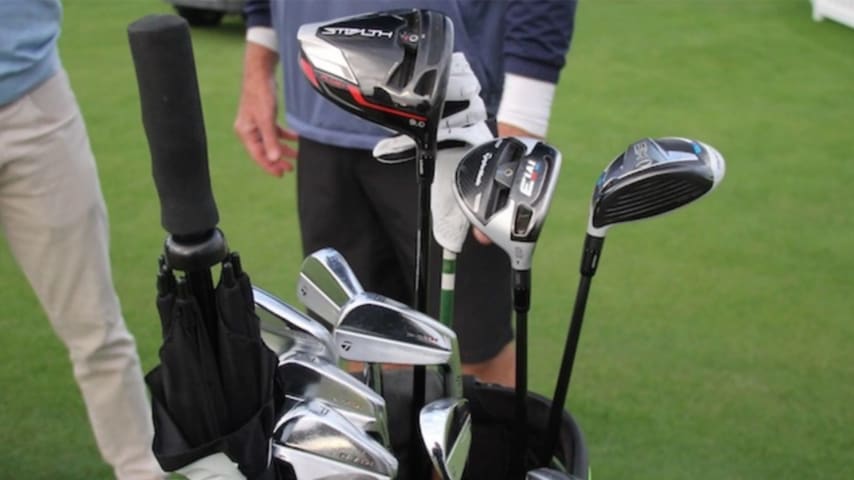6 equipment tweaks Tiger Woods made for PNC Championship
3 Min Read

Written by GolfWRX
When Tiger Woods alters his lineup, it’s huge news in the equipment world. While he didn’t necessarily make any golf club “changes” heading into this week’s PNC Championship, he did make a number of interesting and impactful equipment “tweaks.”
Even his small switch-ups are notable and can offer insight into changes in Woods’ game overall.
Since our last on-site analysis of Woods’ equipment at the PGA Championship at Southern Hills, it appears he’s made slight adjustments to his driver and 3-wood, added weight to his putter head and changed his longtime putter grip. He also made a change to the one piece of equipment that he uses on every single shot.
We break down each of the tweaks below.
Tiger’s driver settings
At this year’s PGA Championship, the 15-gram adjustable sole weight on Woods’ TaylorMade Stealth Plus 9-degree driver was placed slightly toward the draw side of the neutral setting. By placing the weight in that position, the center of gravity (CG) made the head slightly draw-biased.
This week, he’s using a lighter 10-gram weight, and it’s now in the neutral position. All else equal, the driver head would be slightly lighter and comparatively less draw biased.
Not all things are exactly equal, however, because Woods also switched up his hosel settings.
Referencing TaylorMade’s Stealth hosel setting chart, it seems the driver now has a 58.75-degree lie angle, instead of the previous 57.25 degree lie angle. In both settings, the hosel setting creates a 3-degree open face angle compared to standard, and -1.5 degrees of loft.
In general, a more upright lie angle means the driver head will release more easily through impact.
Woods’ driver now has a lighter sole weight, a more neutral sole weight, and a more upright lie angle.
Tiger’s 3-wood setting
As with his driver, Woods also changed hosel settings in his TaylorMade SIM Titanium 15-degree 3-wood.
Referencing TaylorMade’s SIM setting chart, it appears that Woods’ 3-wood is now set to be 1.5 degrees open, has -0.75 degrees of loft, and has a 59.5-degree lie angle. Previously, it was set to be 3 degrees open, had -1.5 degrees of loft, and a 58.75-degree lie angle.
Since Woods is still using the same Mitsubishi Diamana D+ 70TX shaft, and there are no apparent changes to the weight of the head, his 3-wood should now have slightly more spin and launch, with a draw-bias due to the upright lie angle.
Tiger’s putter (and grip) changes
Throughout nearly his entire career, Woods has used a Scotty Cameron Newport 2 GSS prototype putter with a Ping PP58 putter grip, which has a notably thin and light construction. He’s had very brief stints with other putter grips, but it’s the PP58 that’s nearly always had the starting spot.
Woods is using the same putter head this week, but he has switched into what looks to be a Scotty Cameron Pistolini Plus grip that has a heavier 77–80-gram weight, according to Scotty Cameron. His previous Ping PP58 grip, as the name implies, weighs in at just 58 grams. Woods’ new Scotty Cameron grip also appears to show that the usual white lettering on the grip has been darkened, possibly with a marker or otherwise.
Also, as we’ve seen Woods do amidst slower greens and windy conditions at The Open Championship, he’s added a few strips of lead tape to the back of his putter head. The lead tape will add just a few grams of weight, but it can make an impactful change to the feel and performance of the putter.
Based on the wear mark on the center of his putter face, Woods hasn’t missed the center very often throughout the years, so if he’s making tweaks to the setup, it’s likely for a significant purpose.
Tiger’s golf ball change
For years, Woods has been using a Bridgestone Tour B XS TW Edition golf ball, which he co-designed with Bridgestone to achieve increased spin on approach shots and a soft feel. This week, Woods is using a Bridgestone Tour B X model, which has a relatively lower-spinning design. This should allow Woods to pick up more distance on longer shots, while making a small sacrifice to workability and stopping power.




